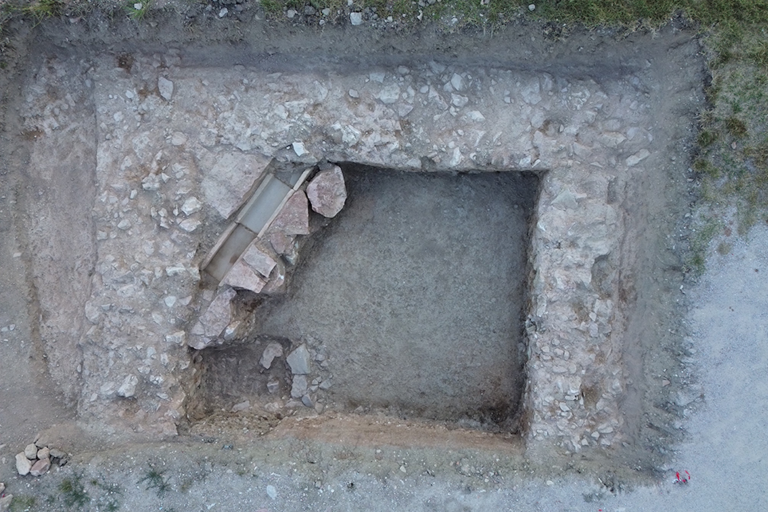A team of archaeologists have discovered the ruins of an ancient pagan temple from the Roman period in Italy.
The temple was discovered during excavations in the ancient hilltop town of Spello, located more than 70 miles north of Rome. The structure is believed to date from the 4th century, during the reign of Emperor Constantine, who ruled Rome between 306 and 337 AD.
Constantine was the first Roman emperor to convert to Christianity. Researchers say the latest findings, announced at the annual meeting of the Archaeological Institute of America, shed new light on the transition from the worship of pagan gods to Christianity within America. Roman Empire.
During their excavations, researchers discovered three walls of a monumental structure that evidence suggests belonged to a Roman temple.
Douglas Boin, a researcher at Saint Louis University who led the excavation at Spello, said News week the temple was a “remarkable” historical discovery.

Douglas Boin
“It shows the continuities between the classical pagan world and the early Christian Roman world, which are often blurred or erased from broad historical narratives,” he said in a press release.
Boin and his team discovered the temple during excavations this summer. Researchers had decided to study the area based on a 4th-century inscription attributed to Emperor Constantine. The ancient inscription, found in Spello in the early 1700s and now on display at the town hall, indicated that the construction of the temple was an “enormous” undertaking.
In the inscription addressed to the inhabitants of the colony, which became a Roman colony in the 1st century BC, the emperor declared that they would be allowed to celebrate a religious festival in their hometown rather than traveling a great distance to get to another party.
But to do this, the emperor declared that the city must erect a temple to Constantine’s divine ancestors, the Flavian family, and venerate them. This practice was part of Roman imperial worship, in which emperors and certain members of their families were revered as divine entities for centuries.
“There was no separation between religion and state in the Roman world, and the Romans’ proud sense of patriotism informed all their public activities, including their worship,” Boin said. News week. “In an empire where people spoke multiple languages, lived on three continents, and maintained their own local traditions, imperial worship brought people together around common ideals.”
The temple would have been used by the pagan inhabitants of Spello during the time of Constantine, Boin said. It was probably erected in the 330s AD and dedicated to the cult of the Flavian family to honor the ancestral line of the emperor.
Scholars had long suspected the existence of the temple, but archaeologists had never identified its precise location. The monumental building discovered by the team, whose foundations measure 4 feet wide and is located near an ancient religious shrine, perfectly matches the available evidence that it is the Temple of Constantine, according to Boin.
“It would have remained in use as a place of worship and religious activities for at least the next two generations until the Christians banned all pagan religion,” he said.
The temple testifies to a “remarkable” religious continuity between the Roman world and the paleo-Christian world, according to Boin.
“Things did not change overnight. Before our discovery, we never had the impression that there were real physical and religious sites associated with this latest ‘imperial worship practice.’ “From the inscription and its reference to a temple, Spello offered very tantalizing potential for a major discovery of an imperial cult under a Christian ruler,” he said in the press release.
The temple discovery represents the greatest evidence ever discovered of imperial worship in 4th-century Italy and the late Roman Empire, according to Boin.
“There is evidence from other places in the Roman world that Christian leaders supported imperial cult practices,” Boin said. “We knew that pagans worshiped their temples in the 4th century, but these findings were all small and inconsequential. And we knew that Christians supported imperial worship.
“This temple bridges these two landmarks, and in this respect it is unlike any temple I know of in the Mediterranean world of the 4th century Roman Empire. Any study of imperial worship in the 4th century Roman Empire 4th century will now have to consider this temple, which is an incredible discovery to make.”

Boin said the discovery indicates how societal changes in Roman times occurred very slowly. Although Constantine was the first emperor to convert to Christianity, it did not become the official religion until around 70 years later. During this period, those who worshiped pagan gods gradually converted to Christianity.
“This (discovery) changes everything about how we perceive the pace of social change and our impression of the impact of social and cultural change,” Boin said.
“This building, in a very radical way, shows us the persistence of pagan traditions that were in place for centuries before the advent of Christianity. We are about to give people a very visible piece of evidence that is earth-shattering really the neat and tidy way people think about big moments of cultural change.
“This Spello building shows us very strikingly that Rome’s first Christian emperor, Constantine, continued the established imperial cult practices of his predecessors. It is a remarkable historical discovery,” Boin said. News week.
“This shows us that the path from paganism to Christianity was strewn with all sorts of strange detours and strange cultural mixtures, not all of which would be remembered fondly by later Church authorities. Just as the pagan Romans mixed patriotism, imperial ideology and religion, the Christian Romans in the time of Constantine did the same.”
Uncommon Knowledge
Newsweek is committed to challenging conventional wisdom and finding connections in the search for common ground.
Newsweek is committed to challenging conventional wisdom and finding connections in the search for common ground.


